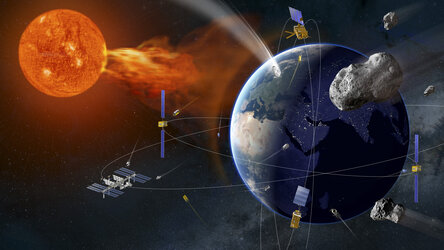Accept all cookies Accept only essential cookies See our Cookie Notice

About ESA
The European Space Agency (ESA) is Europe’s gateway to space. Its mission is to shape the development of Europe’s space capability and ensure that investment in space continues to deliver benefits to the citizens of Europe and the world.
Highlights
ESA - United space in Europe
This is ESA ESA facts Member States & Cooperating States Funding Director General Top management For Member State Delegations European vision European Space Policy ESA & EU Space Councils Responsibility & Sustainability Annual Report Calendar of meetings Corporate newsEstablishments & sites
ESA Headquarters ESA ESTEC ESA ESOC ESA ESRIN ESA EAC ESA ESAC Europe's Spaceport ESA ESEC ESA ECSAT Brussels Office Washington OfficeWorking with ESA
Business with ESA ESA Commercialisation Gateway Law at ESA Careers Cyber resilience at ESA IT at ESA Newsroom Partnerships Merchandising Licence Education Open Space Innovation Platform Integrity and Reporting Administrative Tribunal Health and SafetyMore about ESA
History ESA Historical Archives Exhibitions Publications Art & Culture ESA Merchandise Kids Diversity ESA Brand Centre ESA ChampionsLatest
Space in Member States
Find out more about space activities in our 23 Member States, and understand how ESA works together with their national agencies, institutions and organisations.
Science & Exploration
Exploring our Solar System and unlocking the secrets of the Universe
Go to topicAstronauts
Missions
Juice Euclid Webb Solar Orbiter BepiColombo Gaia ExoMars Cheops Exoplanet missions More missionsActivities
International Space Station Orion service module Gateway Concordia Caves & Pangaea BenefitsLatest
Space Safety
Protecting life and infrastructure on Earth and in orbit
Go to topicAsteroids
Asteroids and Planetary Defence Asteroid danger explained Flyeye telescope: asteroid detection Hera mission: asteroid deflection Near-Earth Object Coordination CentreSpace junk
About space debris Space debris by the numbers Space Environment Report In space refuelling, refurbishing and removingSafety from space
Clean Space ecodesign Zero Debris Technologies Space for Earth Supporting Sustainable DevelopmentLatest
Applications
Using space to benefit citizens and meet future challenges on Earth
Go to topicObserving the Earth
Observing the Earth Future EO Copernicus Meteorology Space for our climate Satellite missionsCommercialisation
ESA Commercialisation Gateway Open Space Innovation Platform Business Incubation ESA Space SolutionsLatest
Enabling & Support
Making space accessible and developing the technologies for the future
Go to topicBuilding missions
Space Engineering and Technology Test centre Laboratories Concurrent Design Facility Preparing for the future Shaping the Future Discovery and Preparation Advanced Concepts TeamSpace transportation
Space Transportation Ariane Vega Space Rider Future space transportation Boost! Europe's Spaceport Launches from Europe's Spaceport from 2012Latest
Mount Aso, Japan
Thank you for liking
You have already liked this page, you can only like it once!
Mount Aso, the largest active volcano in Japan, is featured in this image captured on 1 January 2022 by the Copernicus Sentinel-2 mission.
Zoom in to see this image at its full 10 m resolution or click on the circles to learn more about the features in it.
Located in the Kumamoto Prefecture on the nation’s southernmost major island of Kyushu, Mount Aso rises to an elevation of 1592 m. The Aso Caldera is one of the largest calderas in the world, measuring around 120 km in circumference, 25 km from north to south and 18 km from east to west.
The caldera was formed during four major explosive eruptions from approximately 90 000 to 270 000 years ago. These produced voluminous pyroclastic flows and volcanic ash that covered much of Kyushu region and even extended to the nearby Yamaguchi Prefecture.
The caldera is surrounded by five peaks known collectively as Aso Gogaku: Nekodake, Takadake, Nakadake, Eboshidake, Kishimadake. Nakadake is the only active volcano at the centre of Mount Aso and is the main attraction in the region. The volcano goes through cycles of activity. At its calmest, the crater fills with a lime green lake which gently steams, but as activity increases, the lake boils off and disappears. The volcano has been erupting sporadically for decades, most recently in 2021, which has led to the number of visitors drop in recent years.
Not far from the crater lies Kusasenri: a vast grassland inside the mega crater of Eboshidake. Active just over 20 000 years ago, the crater has been filled with volcanic pumice from other eruptions, with magma still brewing a few kilometres below. Rainwater often accumulates on the plain forming temporary lakes. The pastures are used for cattle raising, dairy farming and horse riding.
One of the nearest populated cities is Aso, visible around 8 km north from the volcano, and has a population of around 26 000 people.
There are 110 active volcanoes in Japan, of which 47 are monitored closely as they have erupted recently or shown worrying signs including seismic activity, ground deformation or emissions of large amounts of smoke.
Satellite data can be used to detect the slight signs of change that may foretell an eruption. Once an eruption begins, optical and radar instruments can capture the various phenomena associated with it, including lava flows, mudslides, ground fissures and earthquakes. Atmospheric sensors on satellites can also identify the gases and aerosols released by the eruption, as well as quantify their wider environmental impact.
The image is also featured on the Earth from Space video programme.
-
CREDIT
contains modified Copernicus Sentinel data (2022), processed by ESA -
LICENCE
CC BY-SA 3.0 IGO or ESA Standard Licence
(content can be used under either licence)

Earth from Space: Mount Aso, Japan

Volcanic eruptions in Japan captured by Envisat

Mount Semeru erupts

Etna erupts















 Germany
Germany
 Austria
Austria
 Belgium
Belgium
 Denmark
Denmark
 Spain
Spain
 Estonia
Estonia
 Finland
Finland
 France
France
 Greece
Greece
 Hungary
Hungary
 Ireland
Ireland
 Italy
Italy
 Luxembourg
Luxembourg
 Norway
Norway
 The Netherlands
The Netherlands
 Poland
Poland
 Portugal
Portugal
 Czechia
Czechia
 Romania
Romania
 United Kingdom
United Kingdom
 Slovenia
Slovenia
 Sweden
Sweden
 Switzerland
Switzerland

























